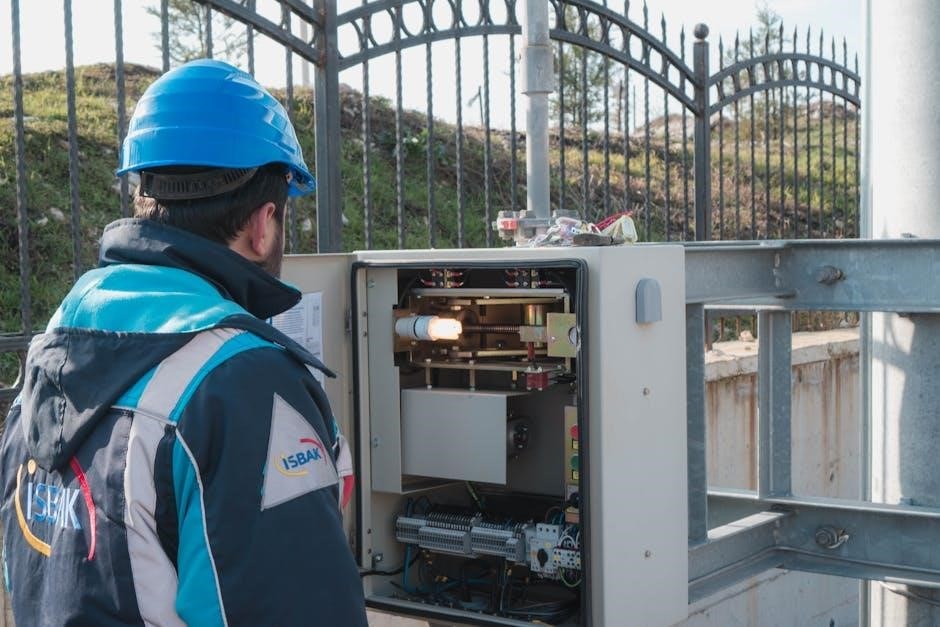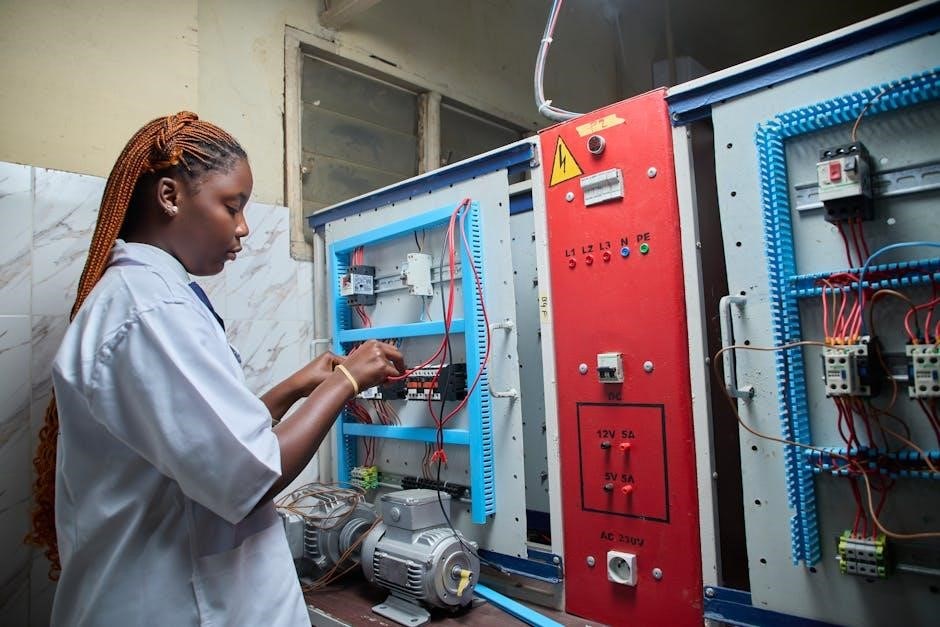Electrical safety quiz questions with answers PDF are essential tools for education and training, providing a comprehensive understanding of hazards, standards, and best practices in electrical safety.
1.1 Importance of Electrical Safety Awareness
Electrical safety awareness is crucial for preventing fires, injuries, and fatalities. It ensures compliance with regulations and promotes a culture of safety in workplaces and homes. Quizzes with answers, like those found in PDF formats, help individuals identify hazards, understand safe practices, and apply standards. Regular assessments reinforce knowledge retention and practical skills, reducing risks in real-world scenarios. By prioritizing electrical safety awareness, individuals and organizations can avoid costly accidents and foster a safer environment. Effective training tools, such as quizzes, play a vital role in maintaining awareness and ensuring everyone can respond correctly to electrical emergencies.
1.2 Purpose of Electrical Safety Quizzes
Electrical safety quizzes serve as a vital tool for assessing knowledge, identifying training gaps, and ensuring compliance with safety standards. They help individuals understand hazards, safe practices, and emergency procedures. Quizzes with answers, often available in PDF formats, provide a structured way to evaluate understanding and retention of critical information. Regular testing reinforces learning, ensuring that individuals can apply their knowledge in real-world scenarios. By focusing on key topics like hazard identification and emergency response, these quizzes promote a culture of safety and continuous improvement. They are an essential component of effective electrical safety training programs, fostering confidence and competence in handling electrical risks.
1.3 Benefits of Using Quiz Questions for Training
Using quiz questions for electrical safety training offers numerous benefits, including enhanced knowledge retention and improved understanding of critical concepts. Quizzes engage trainees actively, making learning more interactive and effective. They also provide immediate feedback, helping individuals identify gaps in their knowledge. Regular testing reinforces key safety practices, ensuring that trainees can apply their skills in real-world scenarios. Additionally, quizzes with answers, especially in PDF formats, offer a standardized way to assess learning outcomes. They cater to different learning styles and provide a clear measure of progress. By incorporating quizzes, trainers can ensure that electrical safety standards are understood and adhered to, promoting a safer work environment.
Types of Electrical Safety Quiz Questions

Electrical safety quizzes include multiple-choice, true/false, fill-in-the-blank, and practical scenario-based questions, each designed to test knowledge and application of safety standards effectively.
2.1 Multiple Choice Questions (MCQs)
Multiple Choice Questions (MCQs) are a popular format in electrical safety quizzes, offering a structured approach to testing knowledge. Each question presents a stem followed by several answer options, typically including one correct answer and distractors. MCQs are effective for assessing understanding of key concepts, such as electrical hazards, safety standards, and emergency procedures. They are widely used in training materials, including PDF downloads, due to their clarity and ease of scoring. MCQs also help identify knowledge gaps, making them a valuable tool for both learners and instructors. Their versatility ensures they remain a cornerstone of electrical safety assessments.
2.2 True/False Questions
True/False questions are a straightforward and effective way to assess knowledge in electrical safety quizzes. Each question requires participants to determine if a statement is correct or incorrect, promoting clear understanding of key concepts. This format is ideal for reinforcing memory and ensuring comprehension of critical safety protocols. True/False questions are commonly included in PDF resources and training materials due to their simplicity and ease of implementation. They are particularly useful for evaluating knowledge retention and identifying areas where additional training may be needed. By focusing on concise statements, True/False questions help learners quickly grasp essential electrical safety principles and their practical applications.
2.3 Fill-in-the-Blank Questions

Fill-in-the-blank questions are a valuable component of electrical safety quizzes, requiring participants to provide specific details to complete a statement. This format tests precise knowledge and ensures learners can recall critical information accurately. Often included in PDF resources, these questions focus on key terms, definitions, and procedures, such as identifying safety standards or listing essential PPE. They are particularly effective for reinforcing technical details and promoting active recall. By leaving out important information, fill-in-the-blank questions encourage deeper engagement and help identify gaps in understanding. They are widely used in training materials to enhance retention and ensure learners can apply their knowledge in real-world scenarios effectively.
2.4 Practical Scenario-Based Questions
Practical scenario-based questions are a crucial part of electrical safety quizzes, as they present real-life situations that require problem-solving and critical thinking. These questions simulate on-the-job challenges, such as responding to electrical fires or handling faulty equipment, ensuring learners can apply their knowledge effectively. Available in PDF formats, these questions often include detailed scenarios followed by multiple-choice or open-ended responses. They are designed to assess a learner’s ability to identify hazards, choose appropriate PPE, and follow safety protocols in specific contexts. Scenario-based questions enhance critical thinking and prepare individuals for actual incidents, making them a key component of comprehensive electrical safety training programs.


Key Topics Covered in Electrical Safety Quizzes
Electrical safety quizzes cover essential topics like understanding hazards, safe work practices, PPE, emergency responses, and compliance with standards to ensure workplace safety and adherence to regulations.
3.1 Understanding Electrical Hazards
Understanding electrical hazards is crucial for preventing accidents. Quizzes cover key risks like electric shock, arc flashes, and fire dangers. They also explain how to identify unsafe conditions, such as damaged cords or overloaded circuits. By testing knowledge on these hazards, quizzes ensure workers can recognize and mitigate potential threats. This section emphasizes the importance of awareness and proactive measures to avoid electrical incidents, aligning with industry standards and best practices for a safer work environment. Regular assessment through quizzes helps reinforce this critical knowledge, ensuring electrical safety remains a top priority in daily operations and decision-making processes.
3.2 Safe Work Practices
Safe work practices are essential for minimizing electrical risks. Quizzes often include questions on proper procedures, such as lockout/tagout, using personal protective equipment (PPE), and de-energizing equipment before maintenance. They also cover protocols for working near live electrical systems and ensuring tools are insulated. These questions help workers understand the importance of following established safety guidelines to prevent accidents. By testing knowledge on these practices, quizzes reinforce habits that reduce the likelihood of electrical incidents. Regular training through quizzes ensures employees stay updated on the latest safety protocols, fostering a culture of compliance and proactive risk management in the workplace.
3.3 Personal Protective Equipment (PPE)
Electrical safety quizzes emphasize the critical role of Personal Protective Equipment (PPE) in preventing injuries. Questions often focus on selecting the right PPE for specific tasks, such as insulated gloves, safety glasses, and arc-rated clothing. They also test knowledge on proper PPE maintenance and inspection procedures. Understanding PPE requirements helps workers protect themselves from electrical hazards like shocks, arcs, and thermal burns. Quizzes ensure employees recognize when and how to use PPE correctly, reinforcing its importance in daily operations. This knowledge is vital for compliance with safety standards and reducing workplace accidents related to electrical exposure.

3.4 Emergency Response Procedures
Electrical safety quizzes often include questions on emergency response procedures to ensure preparedness for incidents like shocks, fires, or equipment failures. These questions cover evacuation protocols, first aid for electrical burns, and proper use of fire extinguishers. Quizzes also test knowledge on isolating power sources and safely rescuing individuals in contact with live electricity. Understanding these procedures is critical for minimizing injuries and preventing fatalities. Regular drills and updates to response plans are emphasized to adapt to new scenarios and technologies. Effective emergency response is a cornerstone of electrical safety training, ensuring workers can act decisively in high-stress situations.
3.5 Electrical Safety Standards and Regulations
Electrical safety quizzes frequently address standards and regulations to ensure compliance with legal and industry requirements. Questions cover OSHA guidelines, NFPA standards, and IEEE recommendations, focusing on workplace safety, equipment maintenance, and hazard control. These quizzes help participants understand the importance of adhering to codes like NEC and IEC, ensuring installations and operations meet safety benchmarks. Regular updates to these standards are highlighted to keep knowledge current. Mastery of these regulations is vital for preventing violations and ensuring a safe working environment. Quizzes also emphasize the role of regulatory bodies in enforcing safety practices and the consequences of non-compliance;

Best Practices for Creating Effective Quiz Questions
- Ensure clarity and specificity in question design to avoid confusion.
- Avoid ambiguity in answers to prevent misinterpretation.
- Incorporate real-world scenarios for practical application.
- Regularly update questions to reflect current standards and regulations.
4.1 Clarity and Specificity in Question Design
Clarity and specificity are crucial in designing effective electrical safety quiz questions. Questions should be concise, avoiding jargon or overly complex language. Ensure each question addresses a single concept to prevent confusion. Use clear instructions and avoid ambiguity in answer options. For multiple-choice questions, provide distinct choices with only one correct answer. For true/false questions, ensure statements are unequivocal. Fill-in-the-blank questions should have unambiguous answers. Practical scenario-based questions should mirror real-world situations. Regularly review and update questions to reflect current standards and industry practices. This ensures relevance and accuracy, making the quiz a valuable training tool for electrical safety awareness and compliance.
4.2 Avoiding Ambiguity in Answers
Avoiding ambiguity in answers is vital for effective electrical safety quizzes. Ensure each question has a single, clear correct answer to prevent confusion. For multiple-choice questions, provide distinct options with no overlap. True/false questions should be unequivocal, avoiding statements that could be open to interpretation. Fill-in-the-blank answers must be specific and unambiguous. Practical scenario-based questions should have clear, definitive solutions. Regularly review answer keys to eliminate any ambiguity. This ensures participants understand the correct responses and reinforces learning. Ambiguity can lead to confusion, undermining the quiz’s effectiveness. Clear answers enhance the reliability and educational value of the quiz, making it a robust training tool.
4.3 Incorporating Real-World Scenarios
Incorporating real-world scenarios into electrical safety quizzes enhances their effectiveness by making them relatable and practical. Use actual workplace situations to test understanding of safety protocols. For example, describe a scenario where a worker encounters a downed power line and ask the appropriate actions to take. This approach helps learners apply theoretical knowledge to real-life challenges. Scenarios should be diverse, covering common hazards like faulty equipment, improper PPE usage, or emergency response situations. Regularly update scenarios to reflect current electrical safety standards and industry practices. This ensures the quiz remains relevant and prepares workers for real-world electrical safety challenges they may face.
4.4 Regular Updates to Reflect Current Standards
Regularly updating electrical safety quiz questions ensures they align with the latest industry standards and regulations. This is crucial as electrical safety guidelines evolve to address new technologies and hazards. Outdated questions can lead to incorrect practices, so quizzes must reflect current standards like NFPA 70E or OSHA updates. Review and revise questions annually or whenever significant changes occur. Utilize resources from reputable organizations to ensure accuracy. Updated quizzes help maintain compliance and reinforce the importance of adhering to the most recent safety protocols. This keeps training relevant and effective in safeguarding workers against emerging electrical risks. Regular updates are essential for continuous learning and safety.

Evaluating Quiz Effectiveness
Evaluating quiz effectiveness involves assessing knowledge retention, identifying training gaps, and measuring improvements in safety behavior. This ensures quizzes remain impactful and aligned with safety goals.
5.1 Assessing Knowledge Retention
Assessing knowledge retention through electrical safety quizzes helps determine if participants understand key concepts. Pre- and post-training quizzes can measure learning improvements. Analyzing scores identifies areas needing reinforcement. Open-ended questions and practical scenarios evaluate applied knowledge. Immediate feedback and detailed explanations enhance retention. Tracking progress over time ensures long-term understanding. Regular updates to quiz content keep information current and relevant. This approach ensures that electrical safety training is effective and that workers can apply their knowledge in real-world situations, reducing risks and improving workplace safety. Consistent assessment helps organizations maintain high safety standards and comply with regulations.
5.2 Identifying Gaps in Training
Electrical safety quizzes are invaluable for identifying gaps in training by pinpointing areas where employees lack understanding. By analyzing quiz results, trainers can determine which topics require additional emphasis. Repeated incorrect answers on specific questions, such as those related to emergency procedures or PPE usage, highlight knowledge deficits. This data allows for targeted improvements in training materials and delivery. For instance, if multiple participants struggle with arc flash safety, additional resources or practical demonstrations can be incorporated. Regularly updating quizzes ensures that evolving standards and practices are addressed, helping to fill gaps and enhance overall electrical safety competence in the workplace.
5.3 Measuring Improvements in Safety Behavior
Electrical safety quizzes with answers PDF serve as effective tools to measure improvements in safety behavior over time. By administering regular assessments, organizations can track changes in employees’ adherence to safety protocols. Correct answers indicating proper PPE usage or emergency procedures reflect better safety practices. Comparing pre- and post-training quiz results helps identify progress and reinforce learning. Consistent improvement in scores suggests successful behavior change, reducing workplace incidents. This data-driven approach ensures that training initiatives yield practical, measurable outcomes, fostering a safer work environment and promoting long-term compliance with electrical safety standards. Regular quizzes thus play a crucial role in sustaining safety behavior improvements.
Resources for Electrical Safety Quiz Questions
Access free PDF downloads, online platforms, and industry-specific materials for electrical safety quiz questions with answers, ensuring comprehensive and up-to-date training resources for all skill levels.
6.1 Free PDF Downloads
Free PDF downloads for electrical safety quiz questions with answers are widely available online, offering a convenient and cost-effective way to access training materials. These resources often include multiple-choice questions, true/false statements, and fill-in-the-blank exercises, covering essential topics like electrical hazards, PPE, and emergency procedures. Many PDFs are designed for specific industries, ensuring relevance and practicality. Platforms like CBSE and safety organizations provide these materials, making them easily accessible for educators, employers, and learners. Regular updates ensure the content aligns with current standards and regulations, making free PDF downloads a valuable tool for continuous learning and compliance in electrical safety training.
6.2 Online Platforms for Quiz Creation
Online platforms for creating electrical safety quizzes offer dynamic tools to design and customize questions, ensuring engaging and effective training. Platforms like Quizlet and Kahoot allow users to craft multiple-choice, true/false, and scenario-based questions, enhancing learner interaction. Many platforms provide templates and analytics to track progress and identify knowledge gaps. They support real-time scoring and feedback, making them ideal for both individual and group training. These tools are accessible from any device, enabling flexible learning. By leveraging these platforms, educators and employers can create tailored quizzes that align with industry standards, fostering a safer and more informed workforce in electrical safety practices.
6.3 Industry-Specific Quiz Materials
Industry-specific electrical safety quiz materials are tailored to address the unique challenges and regulations of different sectors, such as construction, manufacturing, and healthcare. These resources often include PDF formats, offering convenience and accessibility. For example, quizzes for construction might focus on high-voltage systems and equipment safety, while those for manufacturing could emphasize machinery maintenance and lockout/tagout procedures. Many industry-specific materials are developed by experts and align with OSHA standards, ensuring relevance and compliance. They also incorporate real-world scenarios, making training more engaging and practical. Regular updates ensure the content reflects the latest industry advancements, helping professionals stay informed and compliant with evolving safety protocols.

Common Mistakes to Avoid in Electrical Safety Quizzes
Avoiding overly complex questions and ensuring clarity is crucial. Using outdated information and lacking clear instructions can confuse participants and reduce the quiz’s effectiveness in training scenarios.
7.1 Overly Complex Questions
Overly complex questions can confuse participants, reducing the effectiveness of electrical safety quizzes. They may include ambiguous phrasing or unnecessary jargon, leading to misinterpretation. Simplifying language ensures clarity and focus on key concepts. Avoiding intricate scenarios that are not relevant to real-world applications is crucial. Instead, questions should directly address essential safety protocols and standards. By keeping questions straightforward, participants can better grasp and retain critical information. This approach ensures that quizzes effectively assess knowledge and promote practical understanding of electrical safety principles.

7.2 Incorrect or Outdated Information
Using incorrect or outdated information in electrical safety quizzes can lead to misinformation and unsafe practices. This issue often arises when materials are not regularly updated to reflect current standards or regulations. For example, referencing obsolete safety protocols or providing wrong answers can mislead participants. It is crucial to ensure all questions and answers align with the latest industry guidelines, such as those from NFPA or OSHA. Regularly reviewing and updating quiz content helps maintain accuracy and relevance. Additionally, involving subject matter experts in the review process can prevent errors and ensure compliance with current safety standards. Accuracy is vital for effective training and reliable outcomes.
7.3 Lack of Clear Instructions
Lack of clear instructions in electrical safety quizzes can confuse participants and reduce the effectiveness of training. Unclear question phrasing or ambiguous answer options may lead to misunderstandings and incorrect responses. For example, if a question about emergency response procedures is poorly worded, participants may not grasp the correct actions to take. It is essential to ensure that all questions are phrased clearly and that instructions are concise. Providing well-defined answer formats and specific guidance for each question type, such as multiple-choice or true/false, helps participants focus on the content rather than deciphering the question. Clear instructions enhance learning and ensure accurate assessments of knowledge retention and safety understanding.
Electrical safety quiz questions with answers PDF are vital for enhancing knowledge and ensuring safe practices. Regular training and updated resources foster continuous learning and adherence to safety standards.
8.1 Summary of Key Points
Electrical safety quiz questions with answers PDF are crucial for reinforcing knowledge and ensuring compliance with safety standards. They cover hazards, PPE, emergency procedures, and regulations, providing practical insights. Regular training enhances retention and identifies gaps, while updated materials reflect current standards. Quizzes in formats like MCQs, True/False, and scenario-based questions cater to diverse learning needs. Free resources, including PDF downloads, simplify access to training materials. By fostering continuous learning, these tools help reduce risks and promote a safer work environment. Their effectiveness lies in their ability to engage learners and ensure adherence to best practices in electrical safety.
8.2 Encouragement for Continuous Learning
Continuous learning is vital for maintaining electrical safety standards. Regular engagement with electrical safety quiz questions with answers PDF ensures updated knowledge and practical application. These resources are designed to reinforce learning, adapt to new regulations, and address real-world scenarios. Encouraging employees and students to utilize these tools fosters a culture of safety and awareness. By staying informed and proactive, individuals can mitigate risks and contribute to a safer environment. Embrace these materials as a cornerstone for ongoing education and professional development in electrical safety.
Additional Resources
Explore recommended reading materials and links to free quiz PDFs for in-depth learning. Utilize suggested training programs to enhance electrical safety knowledge and compliance with industry standards.
9.1 Recommended Reading Materials
Enhance your knowledge with recommended reading materials such as “Electrical Safety Assessment Test” and “Electrical Fire Multiple Choice Questions.” These resources offer in-depth insights into safety protocols, hazard identification, and compliance standards. Additionally, CBSE competency-based questions provide structured learning for academic and professional development. Free PDF downloads like “Electrical Safety in General Industry & Construction” are invaluable for understanding practical applications. These materials cater to various skill levels, ensuring comprehensive understanding and adherence to electrical safety practices. They are ideal for both beginners and professionals seeking to refine their expertise in the field.
9.2 Links to Free Quiz PDFs
Access free quiz PDFs on electrical safety from trusted sources like Google Drive and official safety websites. Download “Electrical Fire Multiple Choice Questions” and “Electrical Safety Assessment Test” for comprehensive practice. These resources include detailed solutions and cover topics like hazard identification and emergency response. Additionally, find “Electrical Safety in General Industry & Construction” for industry-specific knowledge. Visit platforms offering free PDFs, such as safety training portals and educational websites. These materials are ideal for self-study and professional development, ensuring up-to-date knowledge on electrical safety standards and best practices. Utilize these links to enhance your learning experience effectively.
9.3 Suggested Training Programs
Enroll in structured training programs like the CBSE Competency-Based Questions for a detailed understanding of electrical safety. Utilize the National Safety Council materials, such as their “Electrical Safety Quiz” for practical insights. Explore online platforms like APM: Engineering & Technology for comprehensive courses. These programs cover hazard identification, safe work practices, and emergency response. They also align with industry standards, ensuring relevance and effectiveness. Many programs include quizzes and assessments to reinforce learning. Consider combining these with free PDF resources for a well-rounded educational experience. These training initiatives are ideal for both professionals and students seeking to enhance their electrical safety knowledge and compliance;
